Greenacres Association Calls for Contributions to their Time Capsule
- Details
- Written by: Joanne Wallenstein
- Hits: 5440
 The Greenacres Neighborhood Association (GNA) is planning to bury a 50-year Time Capsule on July 4th and is calling for contributions for the Greenacres Neighborhood Time Capsule 2064 from its neighbors.
The Greenacres Neighborhood Association (GNA) is planning to bury a 50-year Time Capsule on July 4th and is calling for contributions for the Greenacres Neighborhood Time Capsule 2064 from its neighbors.
The GNA is generally looking for writings and photographs that will be appreciated by Greenacres residents in 2062. Imagine the kinds of facts and trivia that would delight you about your house and its occupants back in the 1960's, and what your children will find fascinating about your time in Greenacres when they come back for the unearthing in 2062.
The time capsule will be buried on the grounds of the Greenacres Elementary School, and dedicated at a ceremony to take place during the GNA's Fourth of July celebration, Fri. July 4th, at 11 a.m.
The deadline for contributions to the Greenacres Neighborhood Association 2062 time capsule has been extended to Friday, June 27.
Please mail your contributions to: Greenacres Neighborhood Association, P.O. Box 654, Scarsdale, NY 10583; drop them off at the Scarsdale Library or email GNA's President, Barry Meiselman at barwest2@aol.com.
The deadline for contributions is June 27, 2014.
Scarsdale and Edgemont Family Counseling Service to honor Geraldine Greene at the Gourmet Galaxy
- Details
- Written by: Joanne Wallenstein
- Hits: 5622
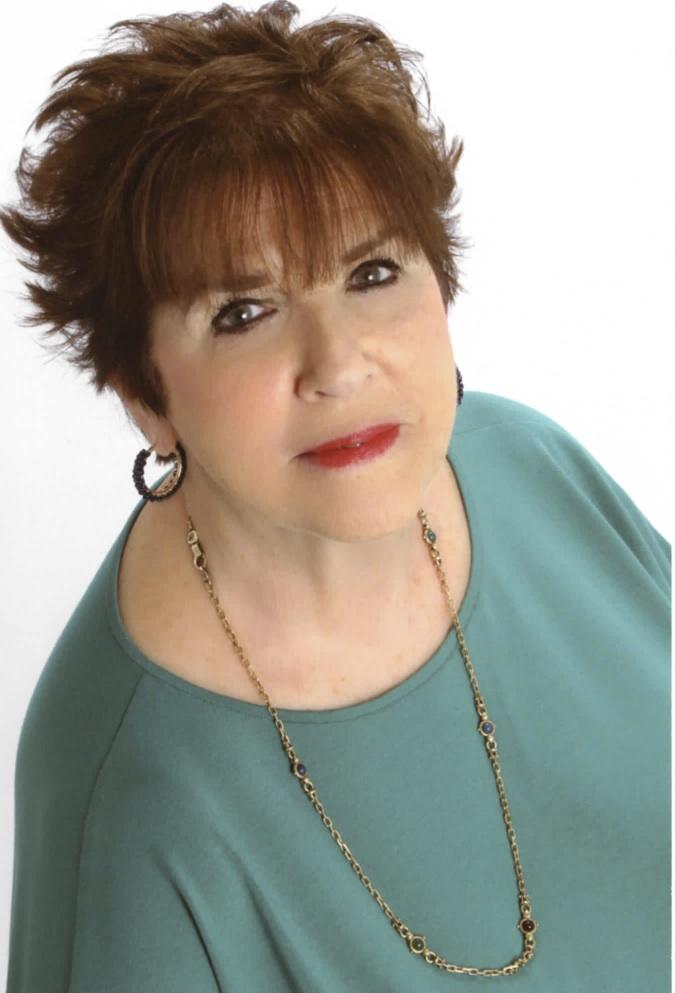 The Scarsdale Edgemont Family Counseling Service will host its annual Gourmet Galaxy celebration at 6:30pm on Wednesday, June 19, 2014 at the Fountainhead in New Rochelle. The event will offer a smorgasbord of cuisine specialties from area restaurants. Unique luxury items and adventures will also be auctioned during the event.
The Scarsdale Edgemont Family Counseling Service will host its annual Gourmet Galaxy celebration at 6:30pm on Wednesday, June 19, 2014 at the Fountainhead in New Rochelle. The event will offer a smorgasbord of cuisine specialties from area restaurants. Unique luxury items and adventures will also be auctioned during the event.
Retiring Executive Director Geraldine Greene will be honored for extraordinary achievement and service. Geraldine has served as SFCS Executive Director for more than 33 years. During her tenure, she overcame numerous obstacles to build an exceptional organization. It is a testament to her that she succeeded because most area communities have been unable to sustain nonprofit counseling services. SFCS is entirely dependent upon the generosity of supporting donors. Geraldine has forged a strong partnership with Village and School Board officials to provide a safety net as well as innovative programs for students, parents and senior residents. Thanks to Geraldine and her expert team, SFCS recently received accreditation by the National Council on Accreditation after passing an arduous examination protocol.
Help support SFCS and honor Geraldine Greene by attending this year's Gourmet Galaxy event. Tickets can be obtained at www.scfsinc.org or by calling the SFCS office at 914-723-3281. Advertisements and congratulatory notes for the Gourmet Galaxy Souvenir Journal can be obtained by contacting John Werner at jrwerner@earthlink.net or 914-472-3880. The copy deadline is June 2, 2014.
NYSG Girls'00 Ranked Number One
- Details
- Written by: Joanne Wallenstein
- Hits: 9810
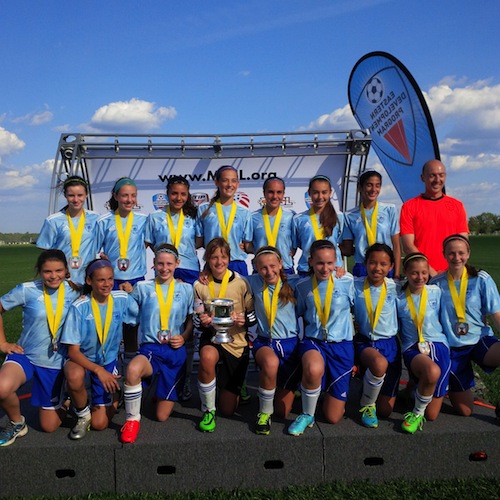 Three Scarsdale athletes learned last week that they are members of the number one youth soccer team in their age group in the United States. Julia Dohle, Olivia Higgins and Allison Stafford, all seventh graders in Scarsdale, are part of the NYSG Girls' 00 team that is undefeated and has not lost a game in over a year. The girls were first exposed to soccer through participation in the Scarsdale Youth Soccer Association.
Three Scarsdale athletes learned last week that they are members of the number one youth soccer team in their age group in the United States. Julia Dohle, Olivia Higgins and Allison Stafford, all seventh graders in Scarsdale, are part of the NYSG Girls' 00 team that is undefeated and has not lost a game in over a year. The girls were first exposed to soccer through participation in the Scarsdale Youth Soccer Association.
New York Soccer Club (NYSC) is a highly competitive youth soccer organization that is dedicated to bringing the highest levels of coaching and leadership training to student-athletes in Westchester and southwestern Connecticut. Players are selected each spring in a highly competitive process. The NYSC Girls '00 team practices from late summer through the end of the school year, with three to four practices per week, regular weekend games and participation in out-of-town tournaments. Games are played against youth soccer teams in the mid-Atlantic and northeast.
This past Memorial Day weekend the team competed in the 2014 EDP (Eastern Development Program) Cup in Hammonton, New Jersey, just outside Philadelphia. In a thrilling championship game, NYSC Girls '00 defeated the #1 ranked team in New Jersey, the South Jersey Elite Barons, 1-0 on a last minute goal. As a result of this tournament win, the team's national ranking catapulted to the #1 ranked Girls 13 and under soccer team in the United States. The ranking is based on points that are tied to the level of competition the team faces and its success on the field.
Allison Stafford plays center defense, Olivia plays right defense and Julia is the goalkeeper and all are on the starting team. Allison hopes to continue to play competitive soccer with her teammates at Scarsdale High School and in college.
Grad Bag Collecting Goods for College Kids in Need
- Details
- Written by: Joanne Wallenstein
- Hits: 5571
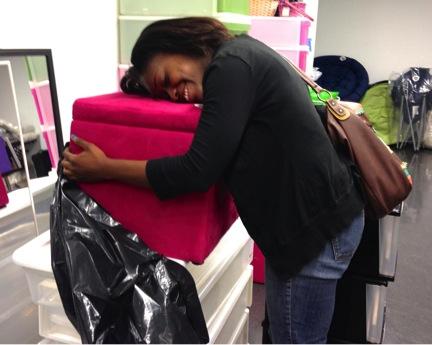 OUT WITH THE OLD, IN WITH THE OLD" is the message Grad Bag advocates as it begins its third year. Grad Bag is a green initiative to collect, recycle and redistribute dorm room items that are often thrown away. Grad Bag is poised to gather, clean and package comforters, sheets, towels, lamps, fans and hangers to stock soon-to-be dorm rooms of incoming freshmen who may not have the means to buy them on their own.
OUT WITH THE OLD, IN WITH THE OLD" is the message Grad Bag advocates as it begins its third year. Grad Bag is a green initiative to collect, recycle and redistribute dorm room items that are often thrown away. Grad Bag is poised to gather, clean and package comforters, sheets, towels, lamps, fans and hangers to stock soon-to-be dorm rooms of incoming freshmen who may not have the means to buy them on their own.
Once again, Grad Bag is partnering with Let's Get Ready at their pre-college orientation in August for students who start college in the fall. Let's Get Ready is an organization which harnesses the energy of college student volunteers to act as tutors and role models, providing free SAT prep, college guidance, financial aid workshops, and mentoring for high school students.
Building on the success of Grad Bag's inaugural event in August 2012, Grad Bag has expanded the effort. From a grass-roots collection, Grad Bag is now working with a few colleges that will assist with collecting on-site.
Grad Bag was founded by Liz Gruber and Tara Tyberg in 2012. When moving their children out of their college rooms Gruber and Tyberg realized that there were a lot of dorm room items that college kids no longer have use for once they have graduated but are in fine condition. The pair contacted their friends and neighbors-parents of recent college graduates- to gather items that would otherwise be thrown away. At the LGR orientation each student selected items from the Grad Bag collection and left with bags full of gear, ready for college.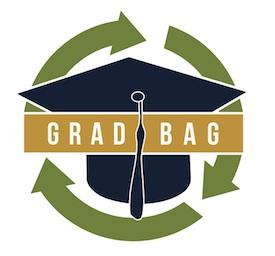
The program's recycling efforts equip college freshmen with all the essentials for dorm life that most of their classmates enjoy, allowing them to begin their college experience with confidence. As a green initiative, Grad Bag is looking out for the future of these students and for the future of our planet.
Grad Bag is still looking for donations. If you know a graduating college senior...Don't throw out those extra long twin sheets, desk lamps and storage containers!!! Grad Bag is also looking for volunteers in June and July to help package the items and get them ready for distribution.
For more information or pick-up, contact: liz@gradbag.org, tara@gradbag.org.
Greenacres Donates 500 Meals for Midnight Run
- Details
- Written by: Joanne Wallenstein
- Hits: 3770
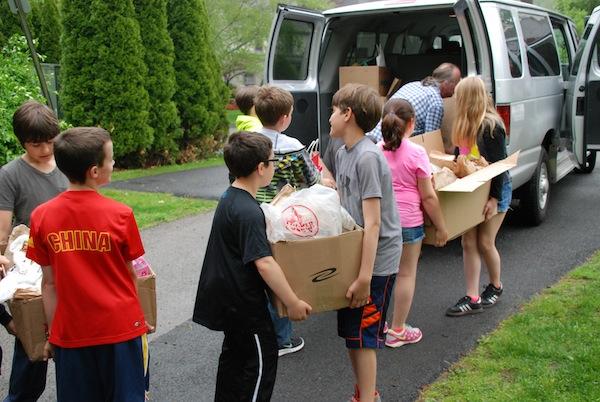 The bagged meal drive for Midnight Run at Greenacres School on May 15th brought 500 lunches for New York City's homeless population. The school's students donated the bagged lunches which were donated to Midnight Run in Dobbs Ferry for distribution in NYC. To learn more about Midnight Run, visit their website.
The bagged meal drive for Midnight Run at Greenacres School on May 15th brought 500 lunches for New York City's homeless population. The school's students donated the bagged lunches which were donated to Midnight Run in Dobbs Ferry for distribution in NYC. To learn more about Midnight Run, visit their website.
Here are Greenacres' fifth graders at work:
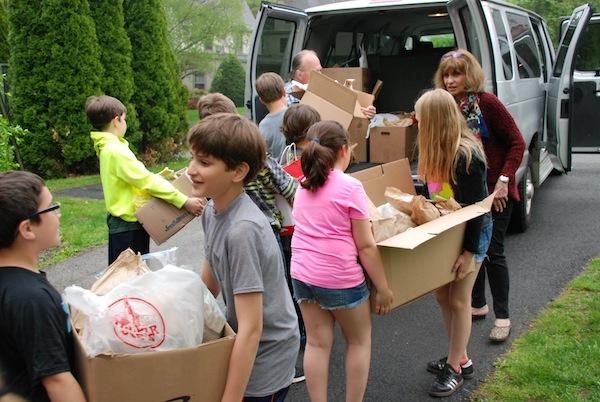 Noah J. and David A., along with fellow Greenacres Elementary fifth graders, load meals for Midnight Run. Teacher-in-Charge Cindy Sansone coordinates the effort.
Noah J. and David A., along with fellow Greenacres Elementary fifth graders, load meals for Midnight Run. Teacher-in-Charge Cindy Sansone coordinates the effort.
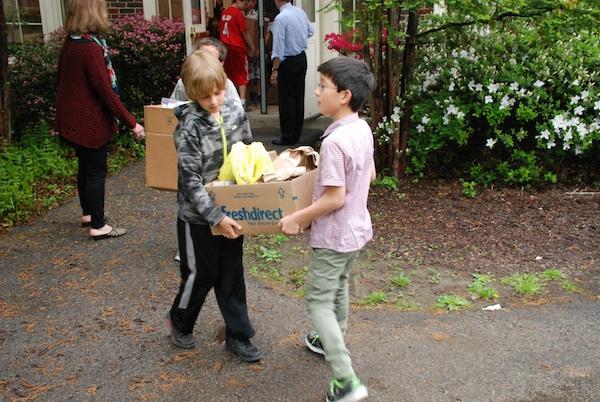 Fifth graders Thomas Z. and Zachary S. load meals that will be served by Midnight Run to homeless men and women in New York City.
Fifth graders Thomas Z. and Zachary S. load meals that will be served by Midnight Run to homeless men and women in New York City.
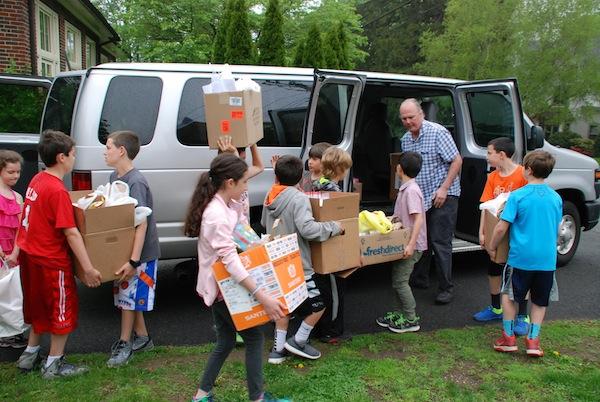 Fifth graders at Greenacres Elementary in Scarsdale helped load over 500 lunches they prepared to be distributed by Midnight Run.
Fifth graders at Greenacres Elementary in Scarsdale helped load over 500 lunches they prepared to be distributed by Midnight Run.
Article by Midori Im, photographs by Eva Romas Wilson










